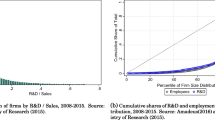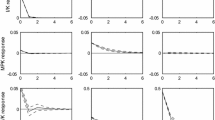Abstract
Do credit spreads signal firm investment opportunities just like Tobin’s q? Because both credit spreads and Tobin’s q are market prices, they should contain similar information about the firm. I develop an investment model in which an analytical relation is established between the marginal q and the credit spreads. Using U.S. firm-level data, I find that credit spreads are a statistically important predictor of firm investment and their explanatory power is higher than that of Tobin’s q. The empirical evidence shows that credit spreads capture the effects of financial frictions, which drive a wedge between marginal and Tobin’s q.



Similar content being viewed by others
Notes
Perhaps the most prominent example of the empirical failure of q-theory is the investment cash-flow sensitivity. Since the seminal work of Fazzari et al. (1988) and summarized by Hubbard (1998), a lot of empirical papers show that investment responds strongly to movements in internal funds (proxied by cash flow) even after one controls for Tobin’s q. However, the recent literature (e.g., Kaplan and Zingales 1997; Erickson and Whited 2000; Alti 2003) finds that cash-flow sensitivity may not be the direct evidence for the failure of q-theory. Chen and Chen (2012) find that its effects diminish over time.
Lehman Brothers collects bid prices from its dealers for bonds that are either traded by the firm or tracked by one of its published bond indices. In months where no bid is posted, a matrix price is recorded as a “best guess”.
Gurkaynak et al. (2007) estimate the U.S. Treasury yield curve from 1961 to date and their daily continuously compounded zero-coupon yields range from 1 to 30 years. I interpolate those yields to get monthly data using cubic method so that on each transaction day we know the risk free discount factors for those cash flows. The data are available at http://www.federalreserve.gov/pubs/feds/2006/200628/200628abs.html.
The numeric values for bond ratings are 1 (Aaa), 2 (Aa1), 3 (Aa2), 4 (Aa3), 5 (A1), 6 (A2), 7 (A3), 8 (Baa1), 9 (Baa2), 10 (Baa3), 11 (Ba1), 12 (Ba2), 13 (Ba3), 14 (B1), 15 (B2), 16 (B3), 17 (Caa1), 18 (Caa2), 19 (Caa3), 20 (Ca), 21 (C), and 25 (D).
References
Abel AB, Eberly JC (1994) A unified model of investment under uncertainty. Am Econ Rev 84:1369–1384
Abel AB, Eberly JC (1997) An exact solution for the investment and value of a firm facing uncertainty, adjustment costs, and irreversibility. J Econ Dyn Control 21:831–852
Abel AB, Eberly JC (2002) Investment and q with fixed costs: an empirical analysis. Working paper, Northwestern Univeristy
Almeida H, Campello M, Weisbach MS (2004) The cash flow sensitivity of cash. J Finance 59:1777–1804
Alti A (2003) How sensitive is investment to cash flow when financing is frictionless? J Finance 58:707–722
Baker M, Wurgler J (2006) Investor sentiment and the cross-section of stock returns. J Finance 61:1645–1680
Bao J, Pan J, Wang J (2011) The illiquidity of corporate bonds. J Finance 66:911–946
Barclay M, Smith CW, Morellec E (2006) On the debt capacity of growth options. J Bus 79:37–59
Baum CF, Thies CF (1999) Q, cash flow and investment: an econometric critique. Rev Quant Finance Acc 12:35–48
Bohn JR, Crosbie PJ (2003) Modeling default risk. Research report, Moody’s KMV Corporation
Bond S, Van Reenen J (2007) Microeconometric models of investment and employment. Handb Econom 6:4417–4498
Brown JR, Fazzari SM, Petersen BC (2009) Financing innovation and growth: cash flow, external equity, and the 1990s R&D boom. J Finance 64:151–185
Chen HJ, Chen SJ (2012) Investment-cash flow sensitivity cannot be a good measure of financial constraints: evidence from the time series. J Financ Econ 103:393–410
Chen S-S, Wang Y (2012) Financial constraints and share repurchases. J Financ Econ 105:311–331
Collin-Dufresne P, Goldstein RS (2001) Do credit spreads reflect stationary leverage ratios? J Finance 56:1929–1957
Duffee GR (1998) The relation between treasury yields and corporate bond yield spreads. J Finance 53:2225–2241
Eberly JC, Rebelo S, Vincent N (2009) Investment and value: a neoclassical benchmark. Working paper, Northwestern University
Erickson T, Whited TM (2000) Measurement error and the relationship between investment and q. J Polit Econ 108:1027–1057
Fazzari SM, Hubbard RG, Petersen BC (1988) Financing constraints and corporate investment. Brook Pap Econ Act 1:141–206
Gilchrist S, Sim J, Zakrajśek E (2010) Uncertainty, financial frictions, and investment dynamics. Working paper, Boston University
Gilchrist S, Zakrajśek E (2007) Investment and the cost of capital: new evidence from the corporate bond market. Working paper, Boston University
Goldstein RS, Ju N, Leland H (2001) An EBIT-based model of dynamic capital structure. J Bus 74:483–512
Gomes J, Schmid L (2010) Equilibrium credit spreads and the macroeconomy. Working paper, University of Pennsylvania
Gurkaynak RS, Sack B, Wright JH (2007) The US Treasury yield curve: 1961 to the present. J Monet Econ 54:2291–2304
Hackbarth D, Miao J, Morellec E (2006) Capital structure, credit risk, and macroeconomic conditions. J Financ Econ 82:519–550
Hadlock CJ, Pierce JR (2010) New evidence on measuring financial constraints: moving beyond the KZ index. Rev Financ Stud 23:1909–1940
Hart O, Moore J (1994) A theory of debt based on the inalienability of human capital. Q J Econ 109:841–79
Hennessy CA, Levy A, Whited TM (2007) Testing q theory with financing frictions. J Financ Econ 83:691–717
Hong G, Warga A (2000) An empirical study of bond market transactions. Financ Anal J 56:32–46
Hubbard RG (1998) Capital-market imperfections and investment. J Econ Lit 36:193–225
Kaplan SN, Zingales L (1997) Do investment-cash flow sensitivities provide useful measures of financing constraints? Q J Econ 112:169–215
Lamont O, Polk C, Saá-Requejo J (2001) Financial constraints and stock returns. Rev Financ Stud 14:529–554
Lee K-W, Lee C-F (2009) Cash holdings, corporate governance structure and firm valuation. Rev Pac Basin Financ Mark Polic 12:475–508
Leland HE (1998) Agency costs, risk management, and capital structure. J Finance 53:1213–1243
Merton RC (1974) On the pricing of corporate debt: the risk structure of interest rates. J Finance 29:449–470
Miao J, Wang P (2010) Credit risk and business cycles. Working paper, Boston University
Myers SC (1977) Determinants of corporate borrowing. J Financ Econ 5:147–175
Ozdagli A (2012) Financial leverage, corporate investment and stock returns. Rev Financ Stud 25:1033–1069
Philippon T (2009) The Bond Market’s q. Q J Econ 124:1011–1056
Schultz P (2001) Corporate bond trading costs: a peek behind the curtain. J Finance 56:677–698
Stambaugh RF, Yu J, Yuan Y (2012) The short of it: investor sentiment and anomalies. J Financ Econ 104:288–302
Stiglitz JE, Weiss A (1981) Credit rationing in markets with imperfect information. Am Econ Rev 71:393–410
Tsai S-C (2005) Dynamic models of investment distortions. Rev Quant Finance Acc 25:357–381
Vassalou M, Xing Y (2004) Default risk in equity returns. J Finance 59:831–868
Whited TM, Wu G (2006) Financial constraints risk. Rev Financ Stud 19:531–559
Yang C-C, Lin C-J, Lu Y-C (2000) Investment strategy, dividend policy and financial constraints of the firm. Rev Pac Basin Financ Mark Polic 3:235–267
Acknowledgments
I thank Murray Frank, Raj Singh, Philip Bond, Robert Goldstein, Frederico Belo, Tracy Wang, Santiago Bazdresch, Jianfeng Yu, Jeremy Graveline, Erica Li, Si Guo, Chaoqun Chen, Xin Li, and seminar participants at the University of Minnesota, the Georgia Institute of Technology, the 2011 China International Conference in Finance, and the 2011 Financial Management Association Annual Meeting for their comments and suggestions. I also gratefully acknowledge financial support from the Carlson School of Management at the University of Minnesota Twin Cities. All errors are my own.
Author information
Authors and Affiliations
Corresponding author
Appendices
Appendix 1: Proof
with \(\gamma _{-}=0.5-\frac{\mu }{\sigma ^{2}}-\sqrt{(0.5-\frac{\mu }{\sigma ^{2}})^{2}+\frac{2(r+m)}{\sigma ^{2}}}\), \(\Gamma =log\left[ \beta \left( \frac{n-1}{n\gamma }\right) \left( \frac{c+m}{\frac{c+m}{r+m}-\frac{\beta }{\psi }}\right) ^{\frac{\theta }{\gamma _{-}}}\right] ^{n-1}\), and \(n=\{2,4,\ldots \}\).
We want to show the investment is more sensitive to credit spreads for firms with low growth and high volatility, and bonds with longer maturity. It is equivalent to show that \(\partial |\frac{1}{\gamma _{-}}|/\partial \mu <0\), \(\partial |\frac{1}{\gamma _{-}}|/\partial \sigma ^{2}>0\), and \(\partial |\frac{1}{\gamma _{-}}|/\partial m<0\).
First, let \(X=0.5-\frac{\mu }{\sigma ^{2}}\) and \(C=\frac{2(r+m)}{\sigma ^{2}}\). It immediately follows that \(\frac{\partial X}{\partial \mu }<0\), and \(\frac{\partial \gamma _{-}}{\partial X}=1-\frac{1}{\sqrt{1+\frac{C}{X}}}\). Since \(\sqrt{1+\frac{C}{X}}>\sqrt{1}=1\), we have \(\frac{\partial \gamma _{-}}{\partial X}>0\). So \(\frac{\partial \gamma _{-}}{\partial \mu }=\frac{\partial \gamma _{-}}{\partial X}\frac{\partial X}{\partial \mu }<0\), \(\frac{\partial |\gamma _{-}|}{\partial \mu }=-\frac{\partial \gamma _{-}}{\partial \mu }>0\), and \(\frac{\partial |\frac{1}{\gamma _{-}}|}{\partial \mu }<0\).
Second, let \(X=0.5-\frac{\mu }{\sigma ^{2}}\), and \(Y=\frac{2(r+m)}{\sigma ^{2}}\). It immediately follows that \(\frac{\partial X}{\partial \sigma ^{2}}>0\), \(\frac{\partial Y}{\partial \sigma ^{2}}<0\), and \(\frac{\partial \gamma _{-}}{\partial Y}=-\frac{1}{\sqrt{X^{2}+Y}}<0\). So \(\frac{\partial \gamma _{-}}{\partial Y}\frac{\partial Y}{\partial \sigma ^{2}}>0\). We have shown \(\frac{\partial \gamma _{-}}{\partial X}>0\), so \(\frac{\partial \gamma _{-}}{\partial X}\frac{\partial X}{\partial \sigma ^{2}}>0\). \(\frac{\partial \gamma _{-}}{\partial \sigma ^{2}}=\frac{\partial \gamma _{-}}{\partial X}\frac{\partial X}{\partial \sigma ^{2}}+\frac{\partial \gamma _{-}}{\partial Y}\frac{\partial Y}{\partial \sigma ^{2}}>0\) and \(\frac{\partial |\frac{1}{\gamma _{-}}|}{\partial \sigma ^{2}}>0\).
Third, let \(Y=\frac{2(r+m)}{\sigma ^{2}}\). We have \(\frac{\partial Y}{\partial m}>0\). \(\frac{\partial \gamma _{-}}{\partial m}=\frac{\partial \gamma _{-}}{\partial Y}\frac{\partial Y}{\partial m}<0\), and \(\frac{\partial |\frac{1}{\gamma _{-}}|}{\partial m}<0\).
Appendix 2: Variable definition
The firm accounting data come from the COMPUSTAT file. The sample period is from 1980 to 2011. Firms with a SIC code that is between 4900 and 4999, between 6000 and 6999, or greater 9000, are dropped. Firms with total asset below 10 million dollars (inflation adjusted in year 2004 dollars), with missing value in investment (item#30) or capital stock (item#7), and negative market to book ratio are also dropped.
Total debt is the sum of item#34 and item#9. Total book value of asset is item#6. Market value of asset is (item#6 + item#24 × item#25 − item#60 − item#74). Book leverage is the total debt divided by book value of asset; market leverage is the total debt divided by market value of asset; investment is the ratio of capital expenditures (item#30) to beginning-of-period capital stock (lagged item#7); Tobin’s q is the market value of assets divided by the book value of assets; cash flow is earnings before extraordinary items and depreciation (item#18 + item#14) divided by the beginning-of-period capital stock; payout ratio is the sum of item#21, item#19 and item#115 divided by item#13; equity issuance is item#108 divided by item#6; sales are item#12; cash holding is item#1; profitability is item#13; R&D is item#46. Sales, cash holding, profitability, and R&D are scaled by the beginning-of-period capital stock. All variables are winsorized at 1 % level each tail every year. Item numbers refer to COMPUSTAT annual data items.
Firm rating is S&P Long-Term Domestic Issuer Credit Rating. This item represents the current rating assigned to the company by Standard & Poor’s. The numeric value is 2 (AAA), 4 (AA+), 5 (AA), 6 (AA−), 7 (A+), 8 (A), 9 (A−), 10 (BBB+), 11 (BBB), 12 (BBB−), 13 (BB+), 14 (BB), 15 (BB−), 16 (B+), 17 (B), 18 (B−), 19 (CCC+), 20 (CCC), 21 (CCC−), 23 (CC), and 27 (D).
Volatility is the annualized monthly stock return volatility. The stock return data come from the Center for Research in Security Prices (CRSP). I calculate the standard deviation in month t using the previous 36 month (month t to month t − 35) stock returns, and require at least 24 month non-missing data.
Rights and permissions
About this article
Cite this article
Shen, T. Credit spreads and investment opportunities. Rev Quant Finan Acc 48, 117–152 (2017). https://doi.org/10.1007/s11156-015-0545-x
Published:
Issue Date:
DOI: https://doi.org/10.1007/s11156-015-0545-x




